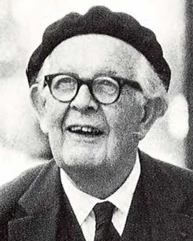
Developmental psychology is the scientific study of how and why humans grow, change, and adapt across the course of their lives. Originally concerned with infants and children, the field has expanded to include adolescence, adult development, aging, and the entire lifespan. Developmental psychologists aim to explain how thinking, feeling, and behaviors change throughout life. This field examines change across three major dimensions, which are physical development, cognitive development, and social emotional development. Within these three dimensions are a broad range of topics including motor skills, executive functions, moral understanding, language acquisition, social change, personality, emotional development, self-concept, and identity formation.

Jean William Fritz Piaget was a Swiss psychologist known for his work on child development. Piaget's theory of cognitive development and epistemological view are together called genetic epistemology.

Imaginary friends are a psychological and a social phenomenon where a friendship or other interpersonal relationship takes place in the imagination rather than physical reality.
In psychology, theory of mind refers to the capacity to understand other people by ascribing mental states to them. A theory of mind includes the knowledge that others' beliefs, desires, intentions, emotions, and thoughts may be different from one's own. Possessing a functional theory of mind is crucial for success in everyday human social interactions. People utilise a theory of mind when analyzing, judging, and inferring others' behaviors. The discovery and development of theory of mind primarily came from studies done with animals and infants. Factors including drug and alcohol consumption, language development, cognitive delays, age, and culture can affect a person's capacity to display theory of mind. Having a theory of mind is similar to but not identical with having the capacity for empathy or sympathy.

Piaget's theory of cognitive development, or his genetic epistemology, is a comprehensive theory about the nature and development of human intelligence. It was originated by the Swiss developmental psychologist Jean Piaget (1896–1980). The theory deals with the nature of knowledge itself and how humans gradually come to acquire, construct, and use it. Piaget's theory is mainly known as a developmental stage theory.
Cognitive development is a field of study in neuroscience and psychology focusing on a child's development in terms of information processing, conceptual resources, perceptual skill, language learning, and other aspects of the developed adult brain and cognitive psychology. Qualitative differences between how a child processes their waking experience and how an adult processes their waking experience are acknowledged. Cognitive development is defined as the emergence of the ability to consciously cognize, understand, and articulate their understanding in adult terms. Cognitive development is how a person perceives, thinks, and gains understanding of their world through the relations of genetic and learning factors. There are four stages to cognitive information development. They are, reasoning, intelligence, language, and memory. These stages start when the baby is about 18 months old, they play with toys, listen to their parents speak, they watch TV, anything that catches their attention helps build their cognitive development.
Egocentrism is the inability to differentiate between self and other. More specifically, it is the inability to accurately assume or understand any perspective other than one's own. Egocentrism is found across the life span: in infancy, early childhood, adolescence, and adulthood. Although egocentric behaviors are less prominent in adulthood, the existence of some forms of egocentrism in adulthood indicates that overcoming egocentrism may be a lifelong development that never achieves completion. Adults appear to be less egocentric than children because they are faster to correct from an initially egocentric perspective than children, not because they are less likely to initially adopt an egocentric perspective.
The A-not-B error is an incomplete or absent schema of object permanence, normally observed during the sensorimotor stage of Jean Piaget's Theory of Cognitive Development.

Peekaboo is a form of play played with an infant. To play, one player hides their face, pops back into the view of the other, and says Peekaboo!, sometimes followed by I see you! There are many variations: for example, where trees are involved, "Hiding behind that tree!" is sometimes added. Another variation involves saying "Where's the baby?" while the face is covered and "There's the baby!" when uncovering the face.
In psychology, centration is the tendency to focus on one salient aspect of a situation and neglect other, possibly relevant aspects. Introduced by the Swiss psychologist Jean Piaget through his cognitive-developmental stage theory, centration is a behaviour often demonstrated in the preoperational stage. Piaget claimed that egocentrism, a common element responsible for preoperational children's unsystematic thinking, was causal to centration. Research on centration has primarily been made by Piaget, shown through his conservation tasks, while contemporary researchers have expanded on his ideas.
Early childhood is a stage in human development following infancy and preceding middle childhood. It generally includes toddlerhood and some time afterward. Play age is an unspecific designation approximately within the scope of early childhood.

In cognitive science and neuropsychology, executive functions are a set of cognitive processes that are necessary for the cognitive control of behavior: selecting and successfully monitoring behaviors that facilitate the attainment of chosen goals. Executive functions include basic cognitive processes such as attentional control, cognitive inhibition, inhibitory control, working memory, and cognitive flexibility. Higher-order executive functions require the simultaneous use of multiple basic executive functions and include planning and fluid intelligence.

Adele Dorothy Diamond is a professor of neuroscience at the University of British Columbia, where she is currently a Tier 1 Canada Research Chair in Developmental Cognitive Neuroscience. One of the pioneers in the field of developmental cognitive neuroscience, Diamond researches how executive functions are affected by biological and environmental factors, especially in children. Her discoveries have improved treatment for disorders such as phenylketonuria and attention-deficit hyperactivity disorder, and they have impacted early education.

Child development involves the biological, psychological and emotional changes that occur in human beings between birth and the conclusion of adolescence.

Joint attention or shared attention is the shared focus of two individuals on an object. It is achieved when one individual alerts another to an object by means of eye-gazing, pointing or other verbal or non-verbal indications. An individual gazes at another individual, points to an object and then returns their gaze to the individual. Scaife and Bruner were the first researchers to present a cross-sectional description of children's ability to follow eye gaze in 1975. They found that most eight- to ten-month-old children followed a line of regard, and that all 11- to 14-month-old children did so. This early research showed it was possible for an adult to bring certain objects in the environment to an infant's attention using eye gaze.
Infant cognitive development is the first stage of human cognitive development, in the youngest children. The academic field of infant cognitive development studies of how psychological processes involved in thinking and knowing develop in young children. Information is acquired in a number of ways including through sight, sound, touch, taste, smell and language, all of which require processing by our cognitive system. However, cognition begins through social bonds between children and caregivers, which gradually increase through the essential motive force of Shared intentionality. The notion of Shared intentionality describes unaware processes during social learning at the onset of life when organisms in the simple reflexes substage of the sensorimotor stage of cognitive development do not maintain communication via the sensory system.
Renée Baillargeon is a Canadian American research psychologist. An Alumni Distinguished Professor of Psychology at the University of Illinois Urbana-Champaign. Baillargeon specializes in the development of cognition in infancy.

Attentional control, colloquially referred to as concentration, refers to an individual's capacity to choose what they pay attention to and what they ignore. It is also known as endogenous attention or executive attention. In lay terms, attentional control can be described as an individual's ability to concentrate. Primarily mediated by the frontal areas of the brain including the anterior cingulate cortex, attentional control is thought to be closely related to other executive functions such as working memory.
Representational insight is the ability to detect and mentally represent the relation between a symbol and its referent. Whether or not a child gains this insight depends on the similarity between the symbol and its referent, the level of information provided about the relationship between the symbol and the referent, and a child's prior experience with symbols. An essential part of representational insight is dual representation or the existence of multiple mental representations of a single symbolic entity. Judy DeLoache coined this term after conducting many studies in which young children would watch an experimenter hide a toy in a model room and were then asked to retrieve a similar, but larger toy from a larger room.
Perspective-taking is the act of perceiving a situation or understanding a concept from an alternative point of view, such as that of another individual.










